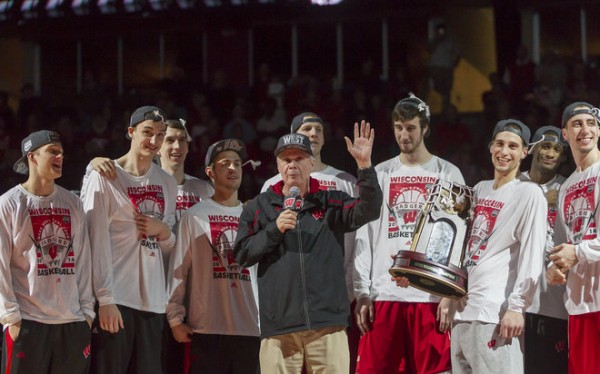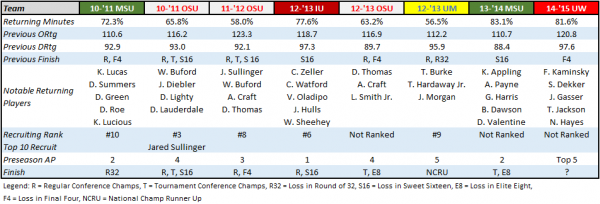How Does Wisconsin Compare With Other Recent Preseason Top 5 Big Ten Teams?
Posted by Alex Moscoso (@AlexPMoscoso) on October 27th, 2014In an earlier post, I argued that Wisconsin’s talent and chemistry made them well-equipped to have another successful season and make a repeat trip to the Final Four. Specifically, the fact that the Badgers return seven of their top eight scorers from last season’s team — including two likely preseason All-Americans in Frank Kaminsky and Sam Dekker — makes them the Big Ten’s best shot at ending its 15-year championship drought. While that sounds hopeful, the Big Ten has had numerous heralded preseason teams since Michigan State’s championship in 2000, and all of them have failed to cut down the nets on the first Monday in April. So, how do these Badgers stack up against some other recent Big Ten preseason top 5 teams? I decided to investigate.

Wisconsin will be in the AP preseason Top 5, and hopes to be the first Big Ten National Champion since 2000. / Andy Manis
Using several metrics, I compared Wisconsin to seven other Big Ten teams that were ranked in the Top 5 of the preseason AP Poll in the past five years. Most metrics are factors that contribute to a team being highly ranked in the preseason: returning minutes, the previous season’s offensive and defensive performances, the previous season’s finish with respect to conference championships and NCAA Tournament advancement, and the quality of the team’s incoming class (based upon Scout.com’s team rankings). The remaining metrics are the team’s preseason AP poll ranking and their finish with respect to conference championship and the NCAA Tournament in that season. The table below compares each team’s metrics.
We can conclude a few things about this year’s Badgers from the above table. First, they have a distinct advantage in experience with 81.6 percent of the previous season’s minutes coming from returning players – only last season’s Michigan State team was more experienced. Next, they are one of the most offensively-efficient teams among the group with an adjusted offensive rating of 120.8 points per 100 possessions in the previous season – only Jared Sullinger’s 2011-12 Ohio State team came into its season with a better rating at 123.3. On the flip side, Wisconsin enters the season with the lowest adjusted defensive rating from the previous season at 97.6 – the next worst team was the Cody Zeller/Victor Oladipo 2012-13 Indiana squad. Additionally, unlike most of the other teams, the Badgers don’t have a heralded recruiting class joining them this year. We can also see that a team’s previous NCAA Tournament succes does not guarantee a deep run the following postseason. Both 2010-11 Michigan State and 2012-13 Ohio State made the Final Four in the previous season – just like this season’s Wisconsin team – and both failed to make it back there a year later. However, the one highly-ranked preseason Big Ten team that did make the Final Four, the 2011-12 Ohio State team, paralells a couple of the same characteristics as the Badgers: a highly-efficient offense with a dominant big man (Sullinger/Kaminsky).
In summary, this table reaffirms a lot of what we already knew about this Wisconsin squad; they are an experienced and offensively-gifted group, but leave themselves vulnerable on the defensive end. If Bo Ryan wants to ensure another banner to hang in the Kohl Center, he’s going to have to get his veterans to revert to playing his traditional feisty Wisconsin defense.













































